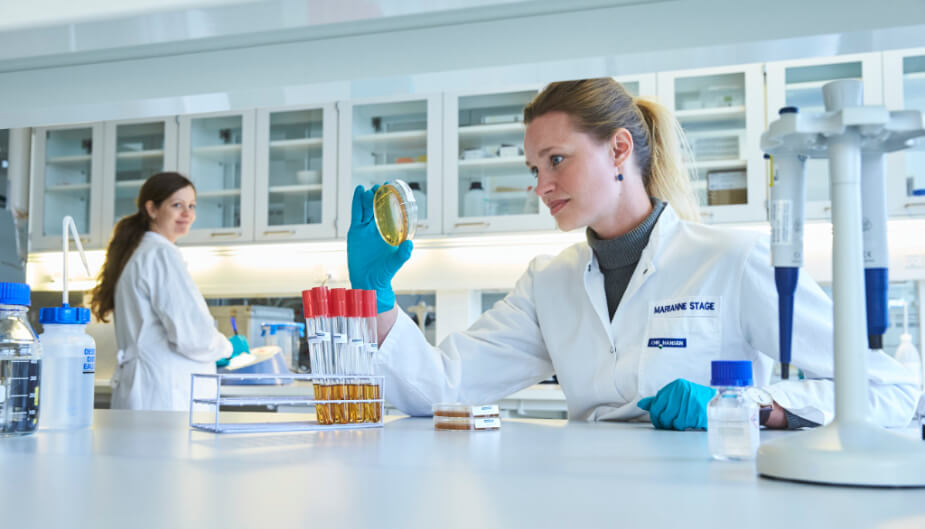Chr. Hansen’s state-of-the-art microbiome research labs
- where we get to know our strains and the science behind them

Probiotics in the gastrointestinal tract
To better understand the potential health benefits of probiotic bacteria, it is imperative to understand how individual probiotic strains work and exert their effects. Different probiotic strains work in different ways and in different parts of the gastrointestinal tract. The journey through the gastrointestinal tract begins when probiotic bacteria enter the mouth (for instance in a probiotic dietary supplement or a yogurt). Once they have survived the acidic environment of the stomach, they travel through the small intestine where they may support healthy immune function.1-10 They then enter the large intestine where they help support a healthy microbiome and help to promote healthy immune function, as well as support the mucus layer and other parts of the intestinal barrier.1-10
We use advanced technology to mimic the human body
In our labs, we have specialized equipment that enables us to study individual probiotic strains in simulated systems. By mimicking the human body in these simulated systems, we obtain unparalleled insights into the potential modes of action of the different probiotic strains. We are able to investigate the human microbiome which helps us better understand human health and how the microbiome ecosystems work with it and influence it.
To view this content, consent for functional cookies needs to be given. Click this text to open the consent form.
The TIM-1 artificial gut system helps us better understand how probiotics interact with the stomach and small intestine
The TIM-1 system is an artificial gut system that simulates the stomach and upper small intestine of the human gastrointestinal tract. It has been validated to accurately replicate the movement, actions, and environment of the stomach and small intestine. This powerful system helps us understand how probiotic strains can travel and survive through the stomach and upper small intestine. The model is flexible and can be used to simulate different situations, for instance, it can replicate the gastrointestinal tract of an adult, child or infant. We can set it to simulate what happens after a meal or during a state of fasting. By being able to control multiple parameters, we can further understand what happens when probiotic bacteria pass through the stomach and small intestine, and the interplay that occurs.
With the TIM-2 artificial gut system we can investigate how probiotics interact with the large intestine
The TIM-2 system replicates a portion of the large intestine, also known as the human colon. The system is made up of four parallel colon systems and by using fecal material from test volunteers and study participants, the microbiomes of infants and adults can be studied. The microbiomes can even be inoculated with different organisms. The microbiome is propagated in an environment that mimics the colon over a period of several days. During this time, what happens to the composition of different bacterial strains in the microbiome can be studied. Microbial metabolites are produced in this replicated system, just as they are in a real human system, and can be analyzed. These metabolites, such as short-chain fatty acids, can have important health benefits. The TIM-2 enables us to understand how the microbiome ecosystem produces these metabolites and also increases our understanding of how the microbiome behaves and functions as a whole.
How probiotics interact with the immune system is another area we study
In the lab, we also work with human blood collected from blood banks and healthy volunteer donors. Using a very specialized method, we use the blood to isolate and grow dendritic cells over the course of five days. Dendritic cells are immune system cells that are important for signaling and directing certain parts of the immune system when it is responding to a challenge. Using specialized equipment in the lab, we combine a probiotic strain with the dendritic cells and then investigate the impact of the probiotic strain on the immune signaling that is consequently induced by the dendritic cells. As there is a normal amount of variation in how different people’s blood responds to stimulation, we analyze each probiotic strain with several different samples of blood from different individuals. Using this technology, we are able to understand on a strain level whether the probiotic bacteria might support a pro- or anti-inflammatory immune response.

We can assess the capability of specific probiotic strains to utilize prebiotics and human milk oligosaccharides (HMOs)
Other work we do involves growing probiotic strains in different conditions to see how well they use specific prebiotics for growth. Human milk oligosaccharides (HMOs) are a type of prebiotic that we particularly focus on. When we conduct complete genome sequencing on specific probiotic strains, we often observe that although the strains contain the genes and machinery appropriate for utilizing certain HMOs and other specific prebiotics, they don’t necessarily function in that way.
To investigate how well a specific probiotic might utilize a specific prebiotic, we use an anaerobic chamber to mimic the atmosphere of the large intestine/colon to grow the probiotic bacteria. We use the anaerobic chamber and a specialized bacterial plate to monitor in real-time if a probiotic strain is growing. The machine allows us to study 384 growth conditions at any one time, enabling us to generate a large amount of data for specific probiotic strains and different HMOs and other prebiotics.
Reliable and reproducible microbiome science data
The in vitro work we are able to do with these specialized systems allows us to look at how probiotic bacteria work in different life stages and ages and under different conditions in an efficient and non-intrusive manner. This technology allows us to build a strong scientific rationale for how and why probiotic bacteria help support different aspects of human health.
TIM-1 and TIM-2 – the TIM company (NL)
The article is provided for informational purposes regarding probiotics and is not meant to suggest that any substance referenced in the article is intended to diagnose, cure, mitigate, treat, or prevent any disease.
References Open Close
1. Hojsak I, et al. Lactobacillus GG in the prevention of gastrointestinal and respiratory tract infections in children who attend day care centers: a randomized, double-blind, placebo-controlled trial. Clin Nutr. 2010;29(3):312-6. (PubMed)
2. Rizzardini G, et al. Evaluation of the immune benefits of two probiotic strains Bifidobacterium animalis ssp. lactis, BB-12® and Lactobacillus paracasei ssp. paracasei, L. casei 431® in an influenza vaccination model: a randomised, double-blind, placebo-controlled study. Br J Nutr. 2012;107(6):876-84. (PubMed)
3. Trachootham D, et al. Drinking fermented milk containing Lactobacillus paracasei 431 (IMULUS™) improves immune response against H1N1 and cross-reactive H3N2 viruses after influenza vaccination: A pilot randomized triple-blinded placebo controlled trial. J Funct Foods. 2017;33:1-10. (Source)
4. de Vrese M, et al. Probiotic bacteria stimulate virus-specific neutralizing antibodies following a booster polio vaccination. Eur J Nutr. 2005;44(7):406-13. (PubMed)
5. Smith TJ, et al. Effect of Lactobacillus rhamnosus LGG® and Bifidobacterium animalis ssp. lactis BB-12® on health-related quality of life in college students affected by upper respiratory infections. The British journal of nutrition. 2013;109(11):1999-2007. (PubMed)
6. Biggerstaff M, et al. Systematic Assessment of Multiple Routine and Near Real-Time Indicators to Classify the Severity of Influenza Seasons and Pandemics in the United States, 2003-2004 Through 2015-2016. Am J Epidemiol. 2018;187(5):1040-50. (PubMed)
7. Putri WCWS, et al. Economic burden of seasonal influenza in the United States. Vaccine. 2018;36(27):3960-6. (PubMed)
8. Jespersen L, et al. Effect of Lactobacillus paracasei subsp. paracasei, L. casei 431 on immune response to influenza vaccination and upper respiratory tract infections in healthy adult volunteers: a randomized, double-blind, placebo-controlled, parallel-group study. Am J Clin Nutr. 2015;101(6):1188-96. (PubMed)
9. Davidson LE, et al. Lactobacillus GG as an immune adjuvant for live-attenuated influenza vaccine in healthy adults: a randomized double-blind placebo-controlled trial. Eur J Clin Nutr. 2011;65(4):501-7. (PubMed)
10. Hojsak I, et al. Lactobacillus GG in the prevention of nosocomial gastrointestinal and respiratory tract infections. Pediatrics. 2010;125(5):e1171-7. (PubMed)
Clinical
studies
Learn how to review the evidence when considering probiotic strains and effects
Our
strains
Read more about some of the world’s most documented probiotic strains and their diverse, beneficial health effects



